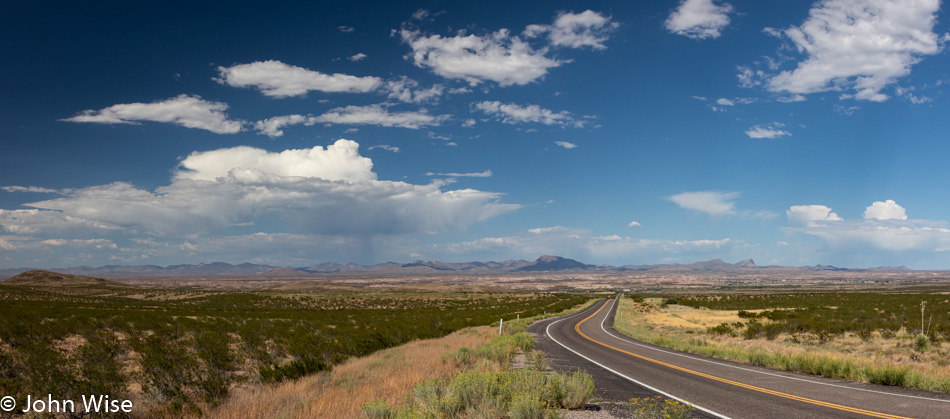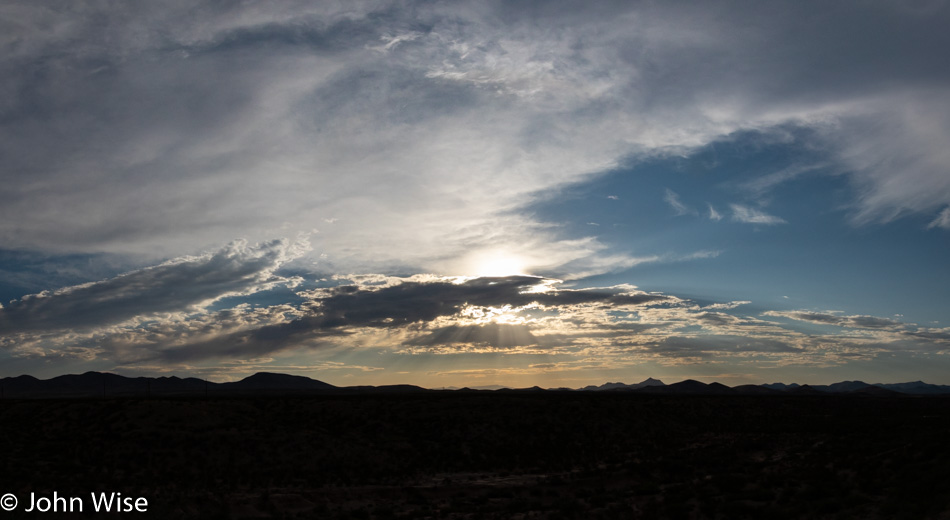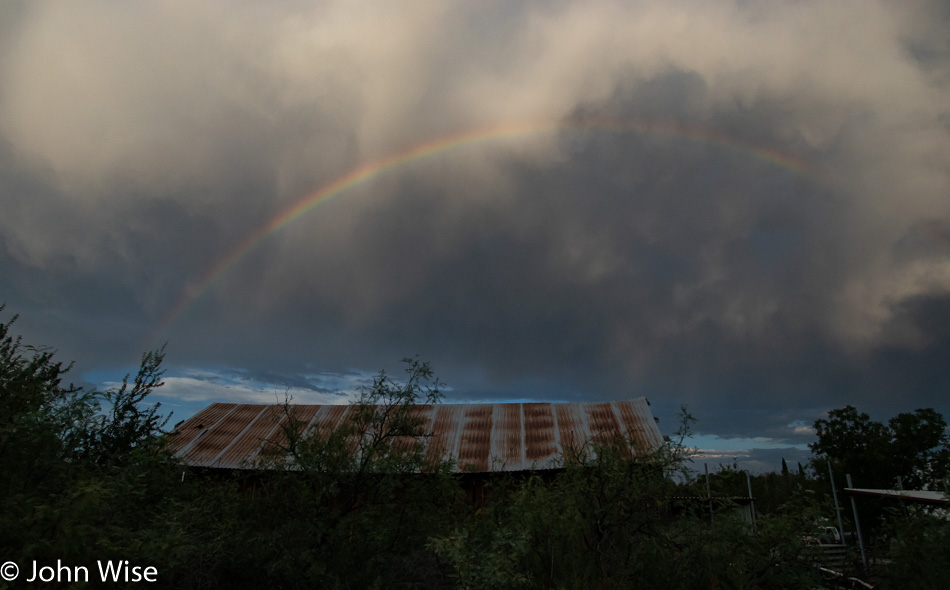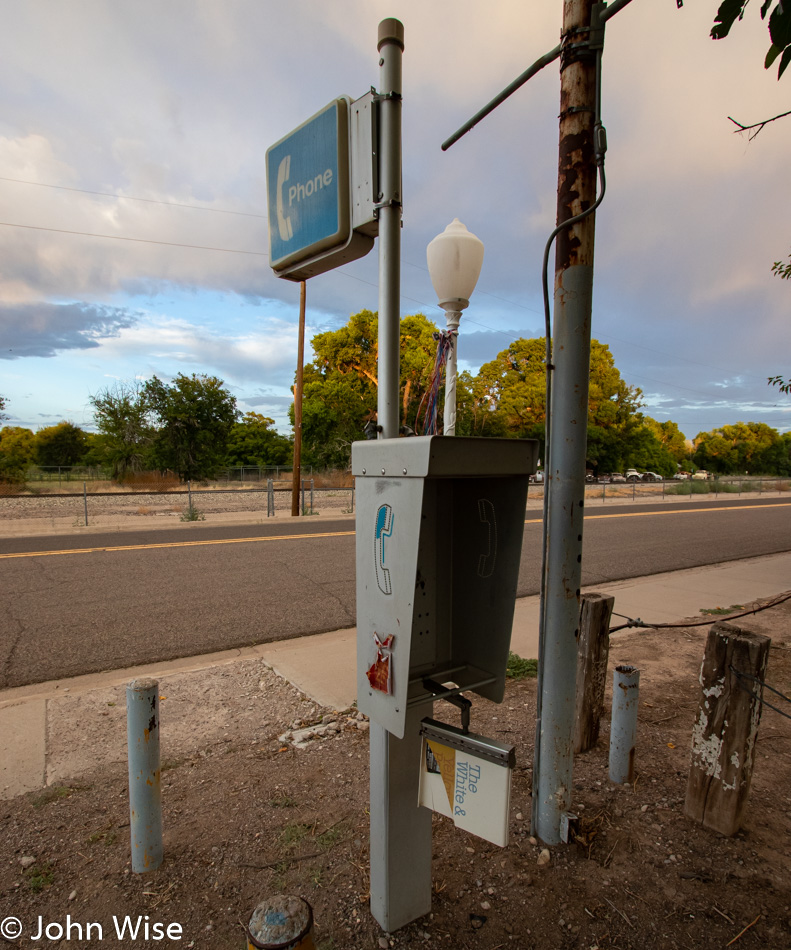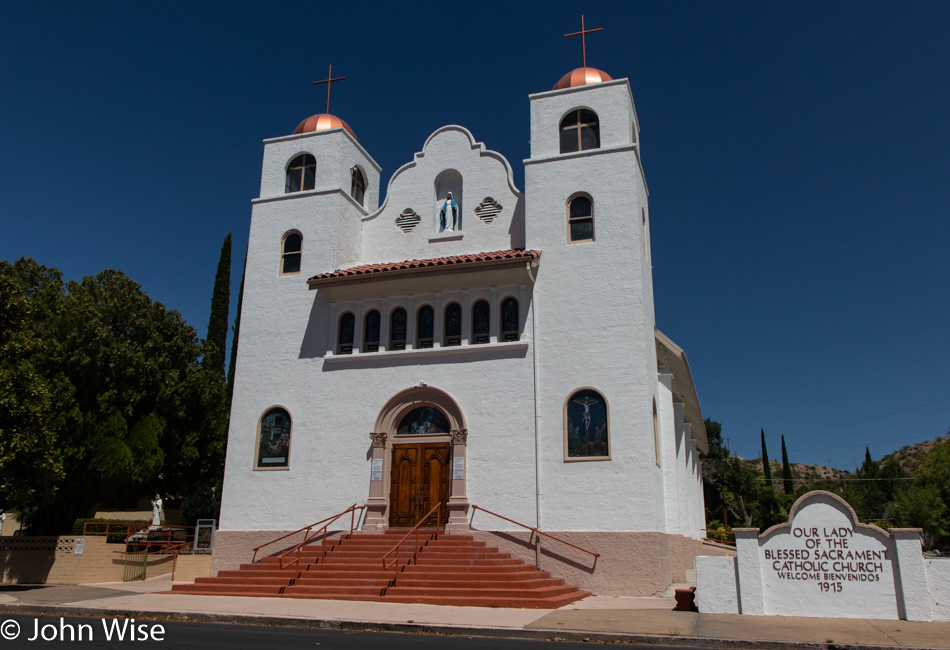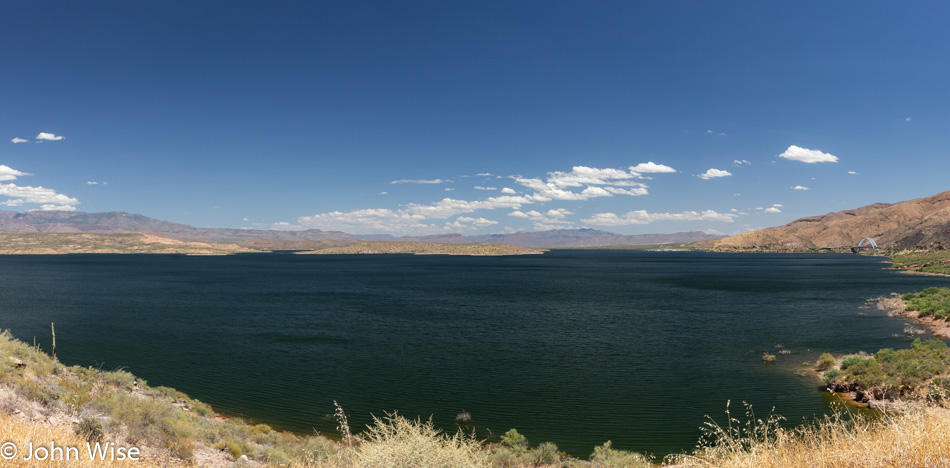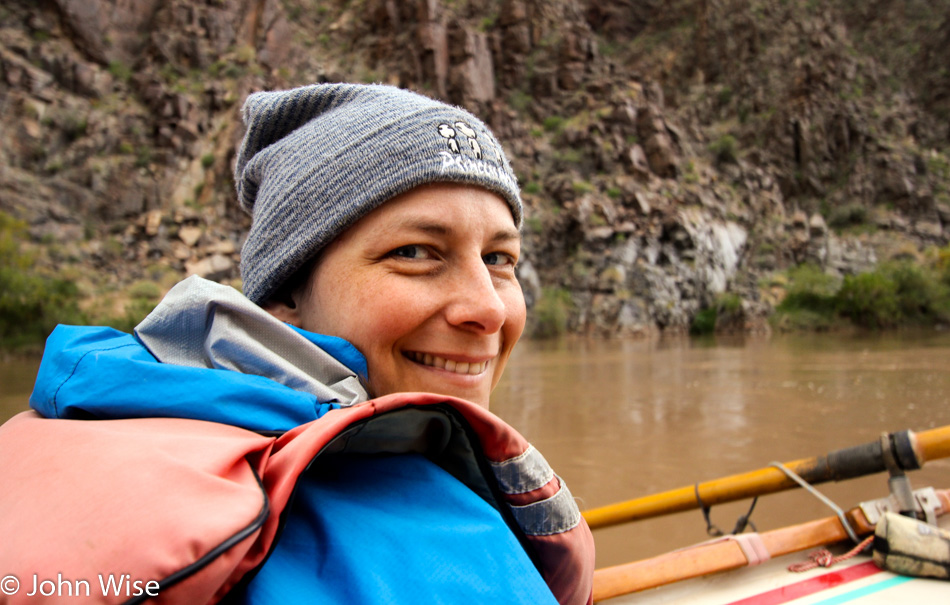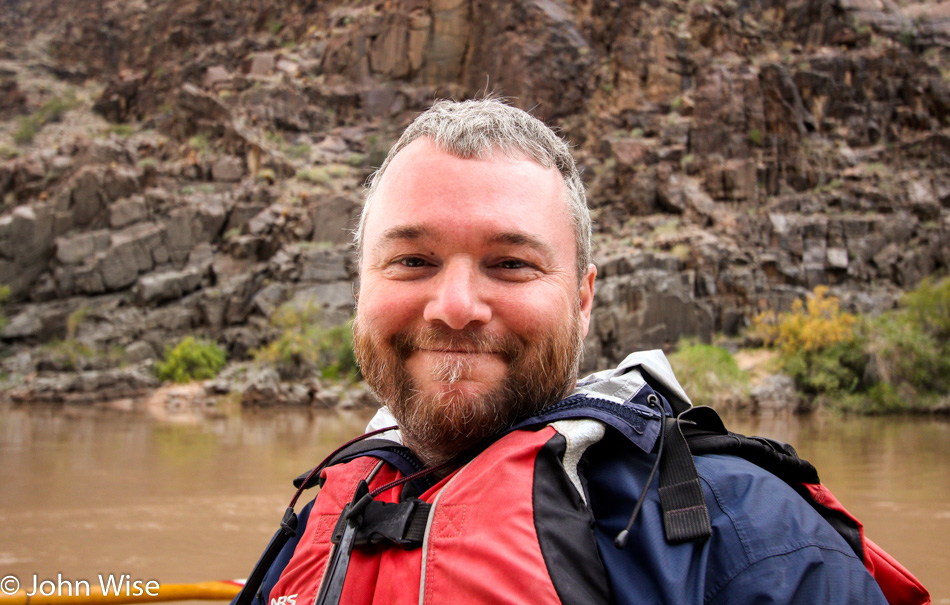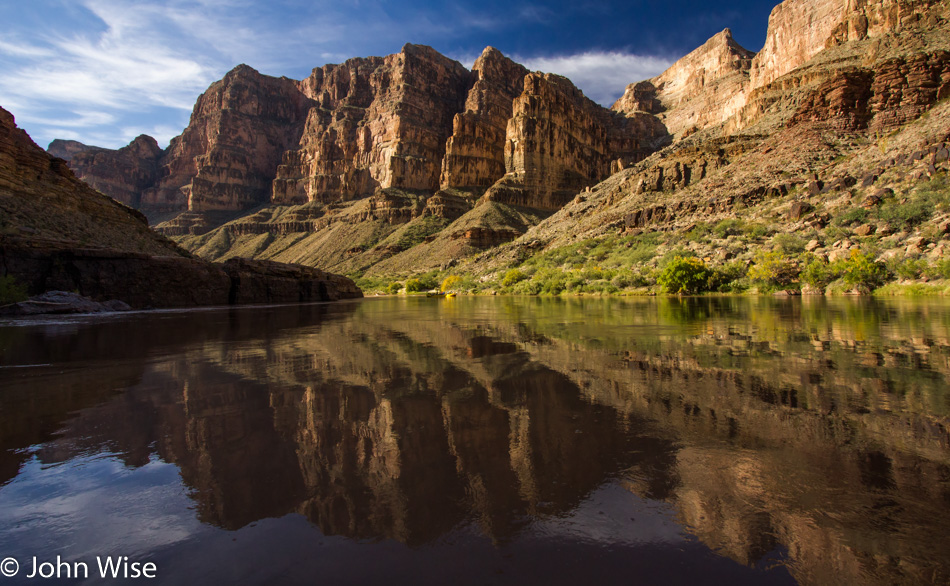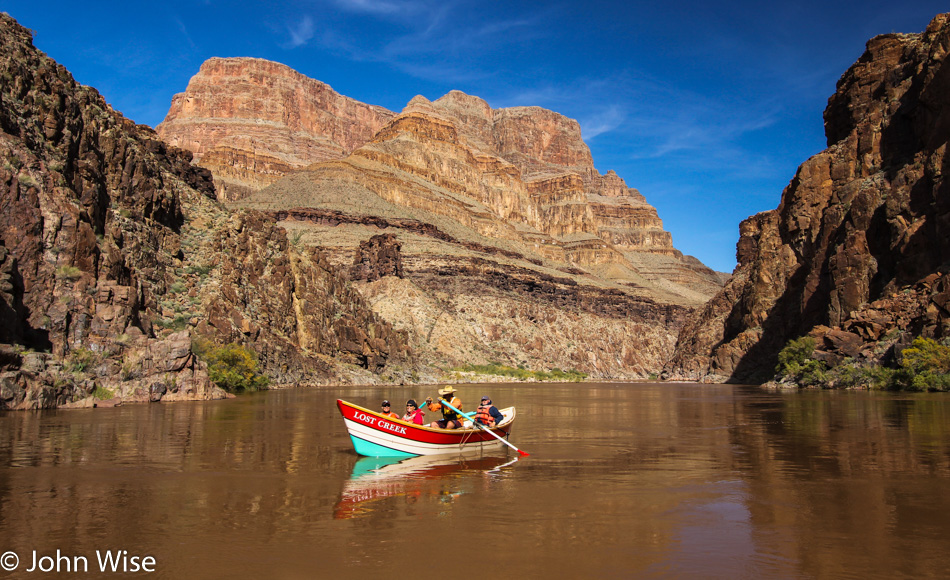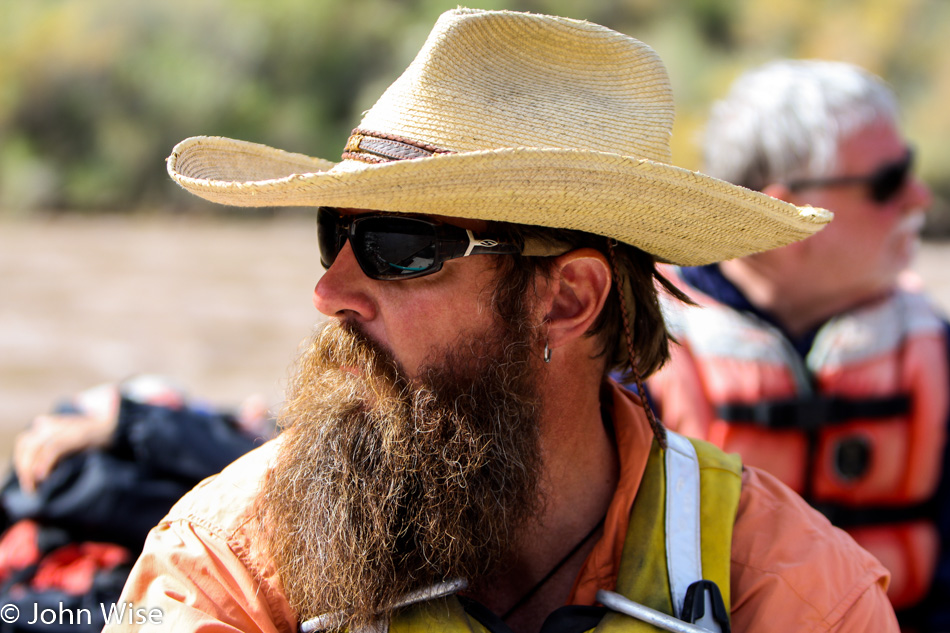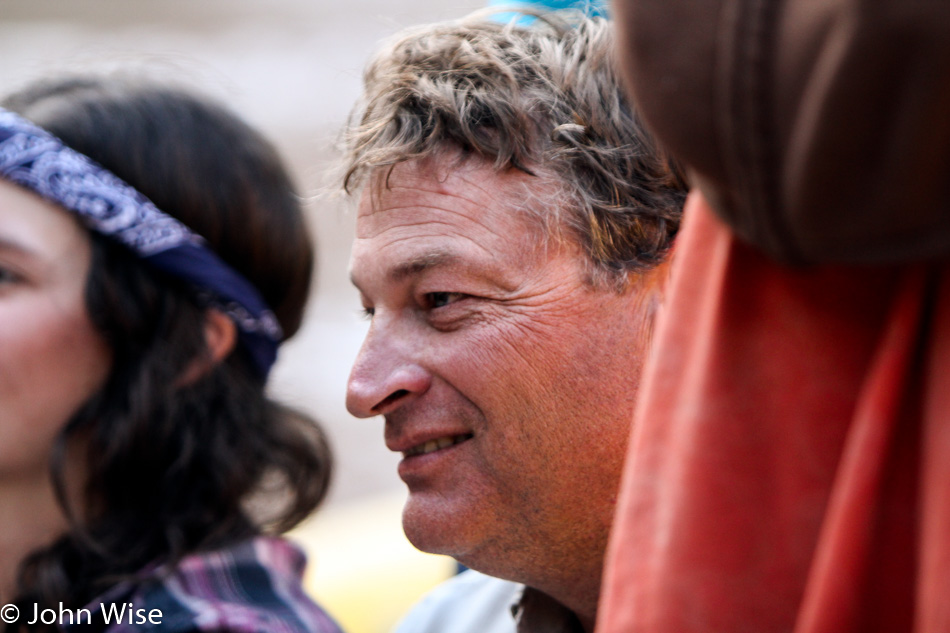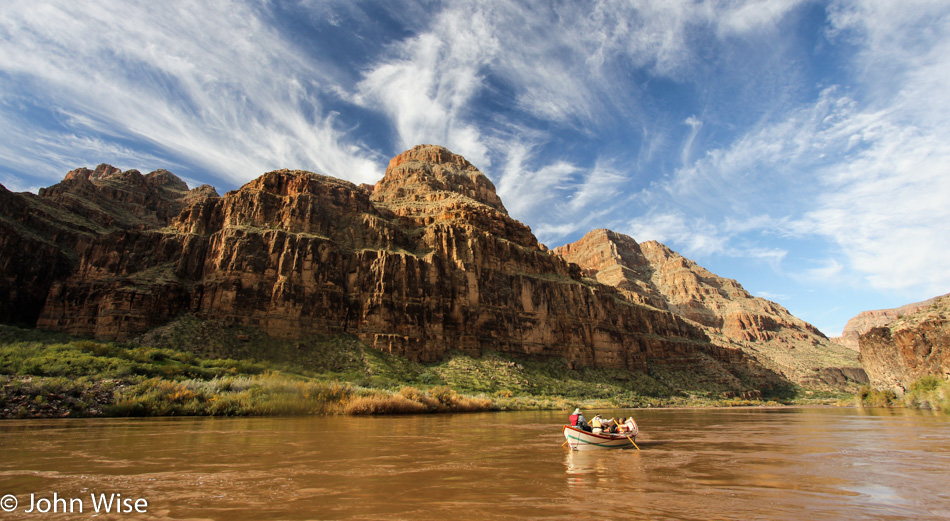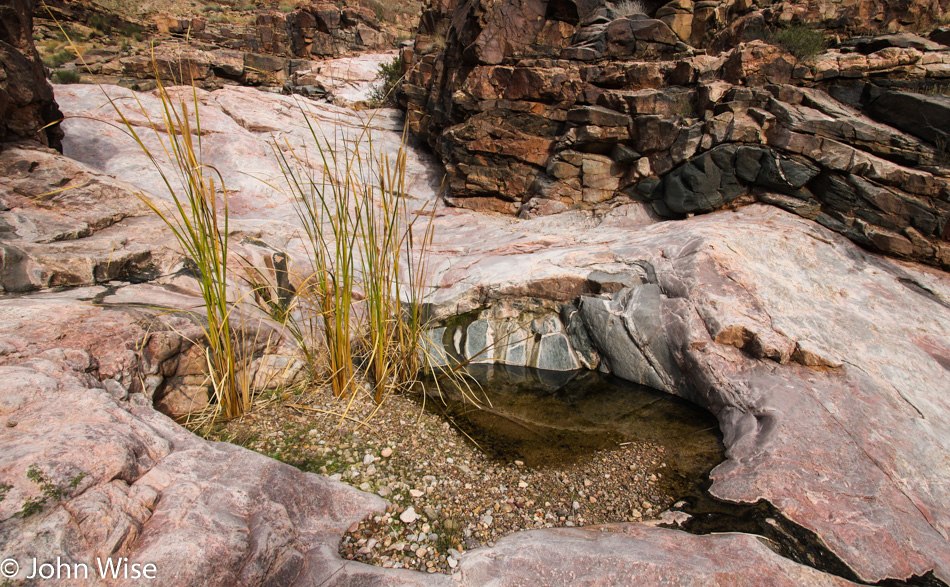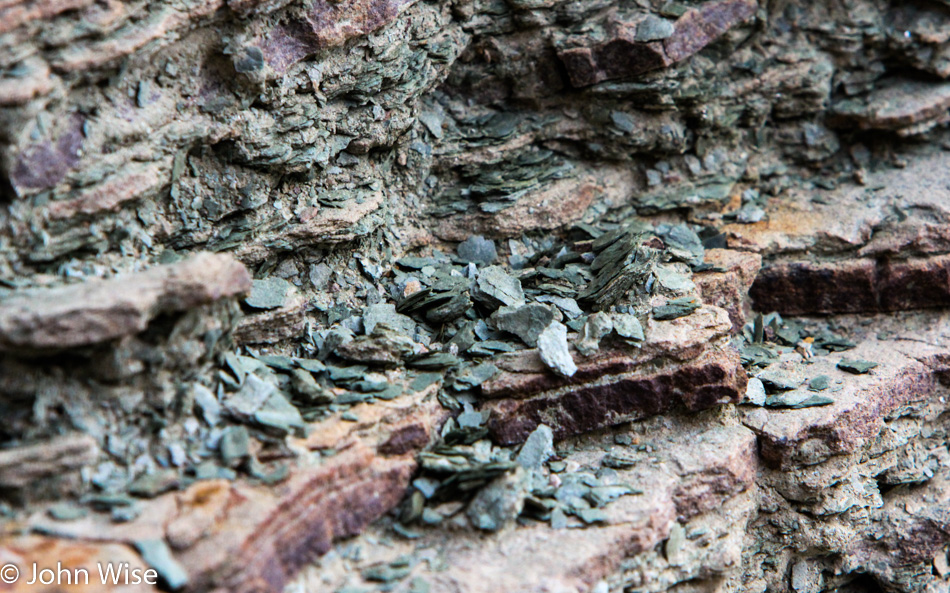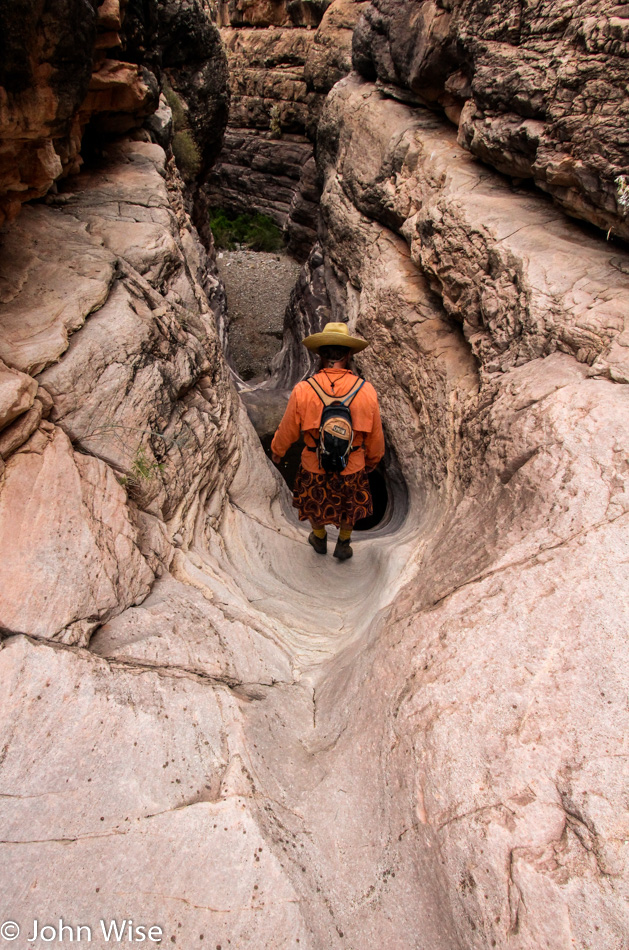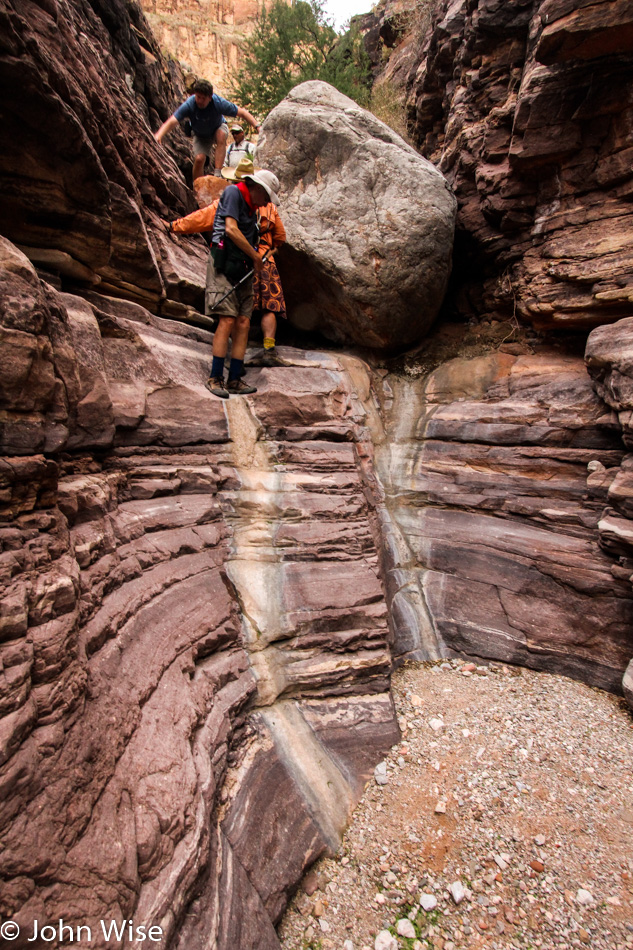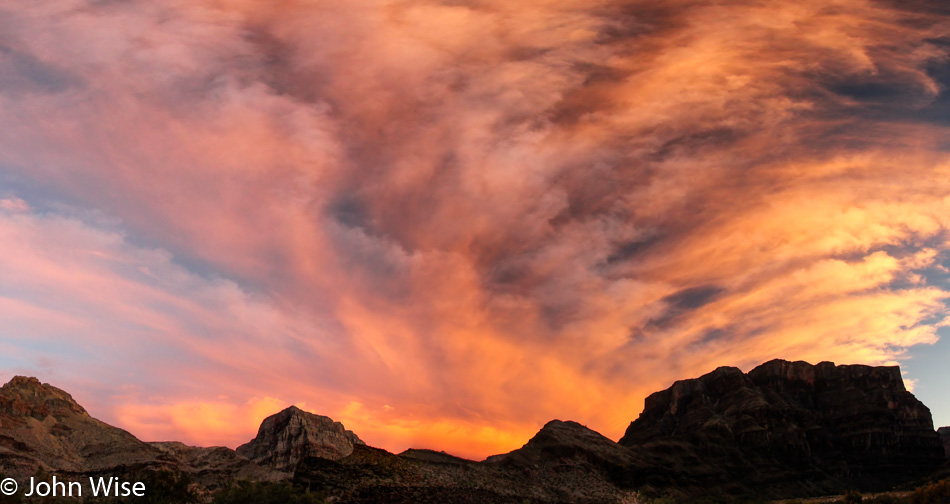
I wanted to proclaim this as the Big Day; the truth is this is the 15th Big Day. What it will also become, though, is the longest day. The now-familiar propane tank’s metallic whoosh fueling the stove lets us know that coffee is on the way. Caroline stirs and we both wake from a light sleep; it’s 4:40 in the morning. Out of the sack, we waste no time rolling up the sleeping bags, mats, and collecting everything else lying around before stuffing it all into our dry bags. With a toss, our stuff is outside the tent before the wake-up call goes out. It must have been the impending reality of this class 8-10 rapid known as Lava Falls, considered to be the most difficult rapid on this trip, that made for a tough night of sleep for all of us. When we exit our tent, I can see that the others are also awake and readying themselves. The boatmen must feel we are all on the move, as no one made the rounds to ensure we were up and packing.
There’s a strange quiet amongst us. At the coffee table, we talk in hushed tones as though we might disturb those who are still asleep, though no one is. There is a flurry of passersby delivering their bags to the rafts. Breakfast is offered in silence; the other passengers continue walking by, off to grab the rest of their gear as they glance over to confirm that food is now on the table. A soft greeting of good morning is exchanged between those eating and those on the move. Another peculiarity of this day is the darkness; not a hint of daybreak has begun to brighten the black sky. Headlamps illuminate the brush, sand, and us. Stray beams of bright white LED lights crisscross the trails. Trees are painted with streaks of the searching, head-mounted torches; the scene is one from the movies when the search party is looking for signs of something – or someone – lost in the forest.
Finally, the crack of a loud voice breaks the quiet, “Last call for breakfast, last call for bags to be loaded on rafts, last call for the Unit, last call for everything!” The kitchen will soon disappear, the dry bags are mostly on the rafts, and the camp will be given the once over to make sure nothing is being left behind. The sky is transitioning out of dark blue. A last-minute lineup at the facilities is delaying our departure. If you think a family sharing a single bathroom is tough, try dealing with 22 people sharing one metal can. As the crowd thins at the Unit, we line up at the dories and rafts.
With some light in the sky to see where we are going, we push off in the Sam McGee. Caroline and Jakki are upfront, and Jeffe is at the oars. I have tightened and retightened the straps of my life jacket, tugged on the elastic bands of my waterproof jacket and pants to seal me in as much as that is possible, and zipped up the jacket until it sits under my chin. My breathing is shallow and rapid. I tell myself it is because of the tightness of the life jacket, recalling our boatmen’s credo, “If you can’t breathe, you can’t drown!” My hands tire as I practice my grip and imagine where I might be holding on when we run Lava Falls.
After an indeterminable amount of time, we arrive at a small pull-out on river left, where we exit the boats to go scout the rapid. I should be clear here: I will not scout the rapid; I will bow down to its awesomeness and silently beg for mercy. Adrenaline is erasing all senses aside from anxious anticipation. I should be calm, though; we have known for months that this day would come. I have watched every online video of rafts, kayaks, canoes, dories, and the occasional inadvertent body surfer who has left their craft to be tossed through the pandemonium of Lava Falls. Maybe I should have skipped the ones that described the clip with the language of doom, such as Carnage at Lava Falls, Lava Falls Flip, Disaster in Lava Falls, or So-and-So Swims Lava Falls.
Anyway, we have a lucky charm on our side. A week before we were to join this adventure, I saw a video posted by one of the boatmen who, on his 116th run of the Colorado, experienced his first flip in Lava Falls. Everyone survived, and his only injury was a broken nose. As soon as I saw this, the light bulb went on. I called O.A.R.S., “Hi, this is John Wise. In a few days, my wife and I are going to be on your 18-day Grand Canyon dory trip, and I was told about a month ago that a boatman named Jeffe Aronson might be one of our guides.” The woman, with an Australian accent, confirms that Jeffe is indeed on our trip. She also identified herself as Carrie Aronson, Jeffe’s wife. I blurt out how perfect this is and begin telling her, “Jeffe posted a video of his dory flipping in Lava Falls last month. Is it possible to put in an early reservation for two passengers to ride with him on the day we’ll be running Lava Falls?” I’m thinking to myself, what are the chances of lightning striking twice? His will be the safest dory to ride that day. Carrie tells me that she’ll be talking to him in a day or so, as he has left California and is on his way to Arizona. When I called back, I was given the wonderful news that there should be no problem with my request; just remind him when we meet at Lees Ferry.
A short walk delivers us to the overlook above Lava Falls. Out in the Colorado, we see the fervor of rage and maniacal force water is capable of creating. The ominous ledge hole is pointed out, and frightening standing waves are casually discussed, making this all sound as though it were normal. While to me, it all looks like a giant frothing mess, and the furthest thing from normal. Pour-overs and dangers here and there determine that we will make our run on a thin line, river left. I’m trying to picture that within minutes, we’ll effortlessly slice a course through this notorious rapid, exiting with all the grace of a ballerina en pointe.
The four cooler heads determine that Jeffe will be part of the first group to make the run. I don’t hesitate after hearing this and bolt back to the Sam McGee. I check and recheck my life jacket, my helmet, my waterproof closures, and then Caroline’s. My camera is gently wrapped in my fleece jacket and stuffed deep into a small dry bag before being wedged into the hatch behind me. On my right, I have affixed a clamping tripod to the gunwale with my tiny GoPro firmly attached. Extra Velcro straps loop around the tripod legs and are locked tightly before I’m as satisfied as I can be that this camera will still be attached to the dory upon exiting Lava Falls 23 seconds after we enter it. I’m ready.
Here goes the first group, but it’s not my group. A last-minute change determined that Jeffe would be in the second group. I’m too freaked out waiting for our run to consider unpacking my camera and heading back up the hill and video the group that is now running first. I will not be the reason that my boatman is distracted; I will not be the cause of a delay – I stay put, remaining tense, remaining nervous, and more than a little thrilled.
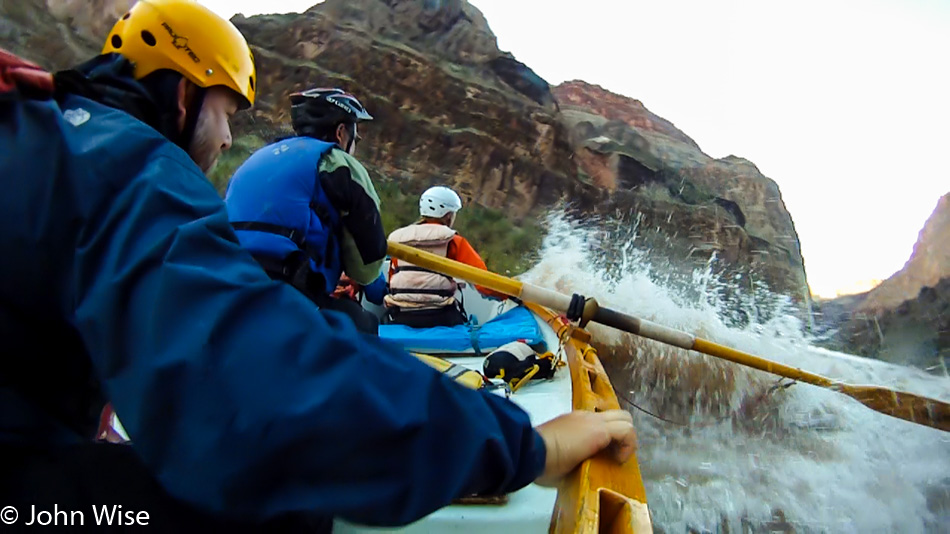
The first group pushes off and floats away. There is no view from this small cove to be able to size up how the other boaters fare once they cross the horizon and disappear into the void. In a few brief moments, a serious Jeffe is moving fast in our direction, “Get in, we’re doing this,” followed by, “Andrea went overboard, but her mom reached in to pull her back onto their raft. Everybody ready?” Startled, I have no time to pop my eyeballs back into their sockets or lower my eyebrows that have shot above my hairline.
Jeffe’s question wasn’t asked with any expectation of an answer anyway. He pushes us off from the shore, steps in behind me, and takes his place at the oars. “We’re going in on the left. When I yell ‘high side’ – be there, and we’ll get through this.” We know the routine by now. No questions, no joking, no distractions. Jeffe asks Jakki to inch to the right to bring the dory into trim; we are level. As if in slow motion, we approach Lava Falls. We are on calm water, so calm that what must be over the horizon doesn’t seem real. Time is dragging me to a halt as every second expands with frenetic anticipation. My grip is fixed, as is my line of sight, on what will shortly trounce all of my senses.
“Okay, let’s pay attention!”
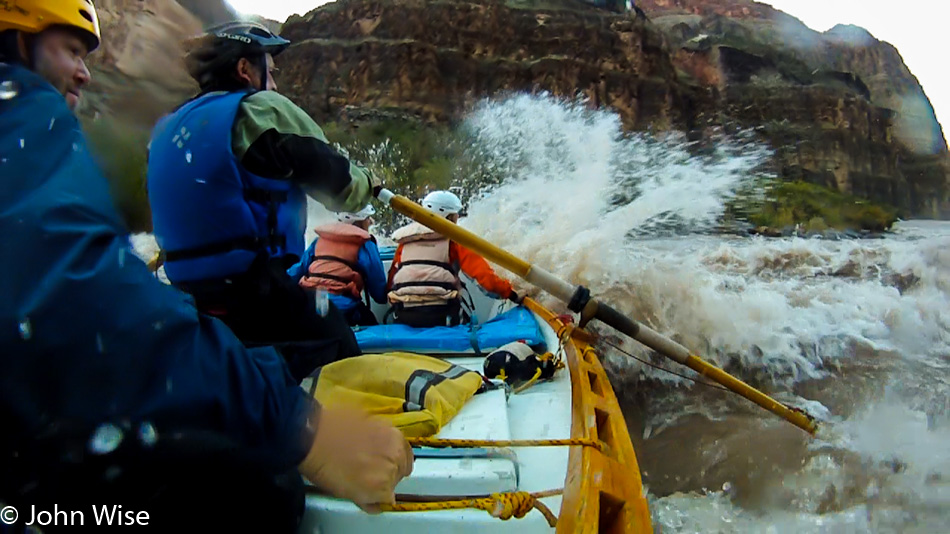
The dory is accelerating as the angle of descent and gravity start to pull the river down into the rapid. I can’t tell if we are on the tongue. I don’t even know if this rapid has one, but as the water starts to whip into white peaks on the left, we are still on a final short stretch of nearly calm water. This all feels too easy. Like a familiar formula unfolding before us, we should go from calm to rushing forward into chaos, then a bit of being tossed about before the exit. But this is Lava Falls.
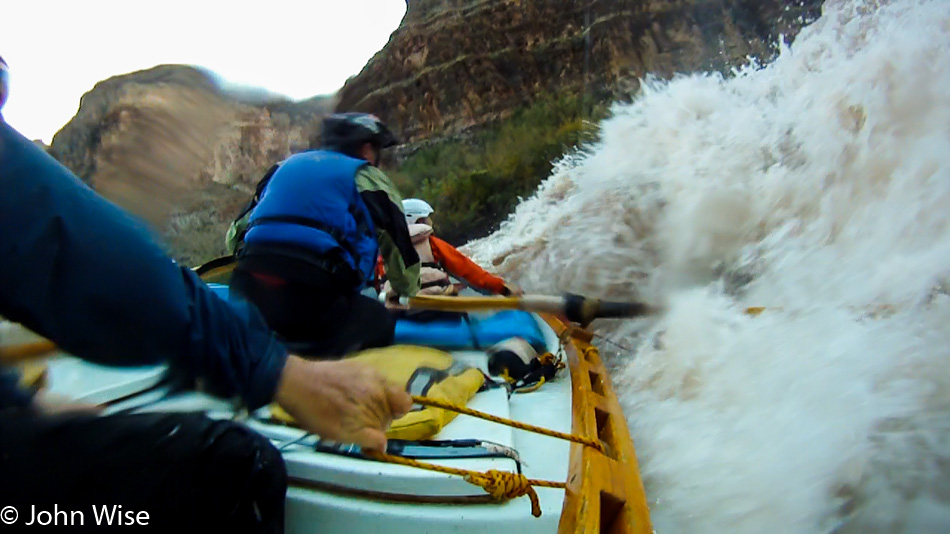
Then, the frenzy begins. Calm is destroyed, and an infinite field of churn without an inch of pleasantry is about to chew us up. Is that the ledge hole? We drop into the convulsing volcano without ceremony; the waves around us are a blur. A growing lateral beast of water is building an impenetrable wall as we start to turn sideways. There is no time to yell “High side!!!” – we are going into battle with a dory-flipper. Jeffe dives hard to the right, and I follow, just as we had been instructed to do if we can’t hear the boatman’s commands. We are still upright, with all four of us in our seats, as we emerge from the wave that swamped our dory only seconds into our run, but we are completely turned around, plowing through Lava in reverse. The oar that should be in Jeffe’s left hand is missing. While still leashed to the dory, it has jumped its oarlock and is floating outside the boat, too far to reach, as it is being whipped through Lava Falls just as we are.
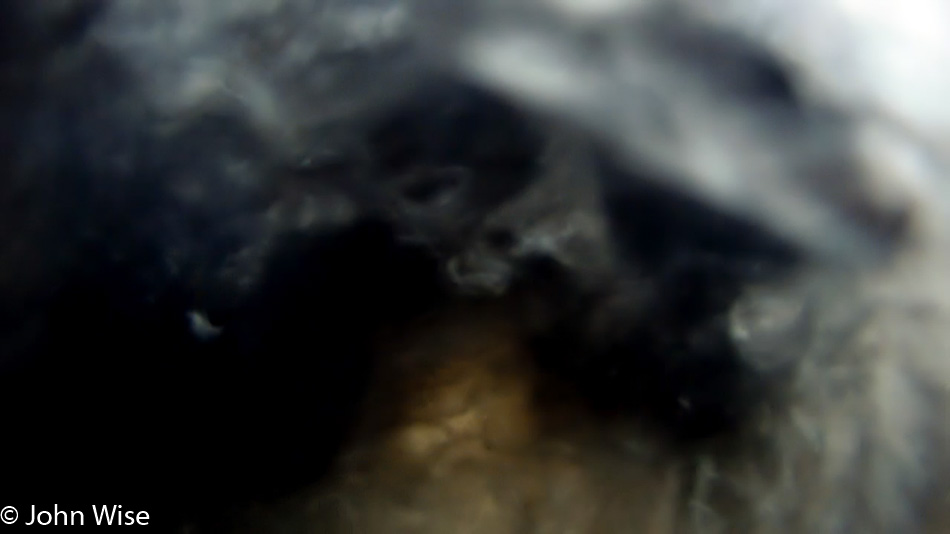
Blind to what hazards lie in our trajectory, I make a quick decision not to look behind me for three reasons. One, looking back at what should be the front will not help me guide us past whatever approaching horror may lie in wait to yet flip us or smash the Sam McGee to bits. Second, looking around, I might shift the trim of our water-filled dory that is not yet safe to start bailing out. Third, I am transfixed on Jeffe, waiting to see just what he is going to do with only one oar.
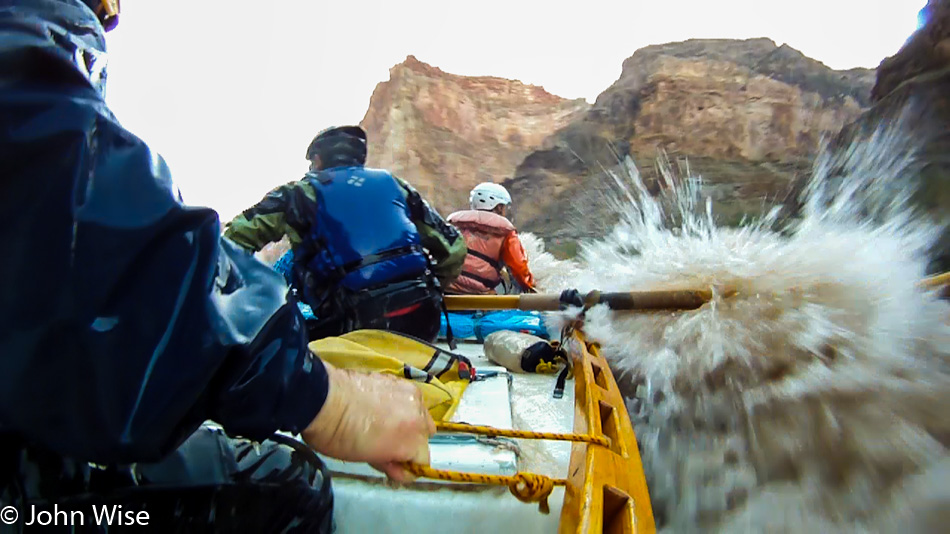
I see Caroline and Jakki up front and wonder what is going through their minds regarding our new situation of running Lava Falls backward. During the second that followed our 180-degree turn-around and loss of an oar, the women appeared content watching where we had been and were likely unaware that we were racing through the rapid with but one oar. Two seconds after our fate changing turn-about I become calmer, more relaxed about our situation than I was 30 seconds prior to arriving at the entry to Lava Falls.
I am far from panicking and content in knowing that there is nothing any of us can do but ride into the mystery of the unknown. Early river runners would guide their boats through the big rapids from shore, with attached ropes to “line” the crafts through what they considered unrunnable whitewater. Others would portage their boats. I don’t know which of the two methods one-armed civil war veteran John Wesley Powell employed from rapid to rapid, but I know that right now, we are in Lava Falls, running one-armed in reverse, right down one of the angriest rapids on the Colorado.
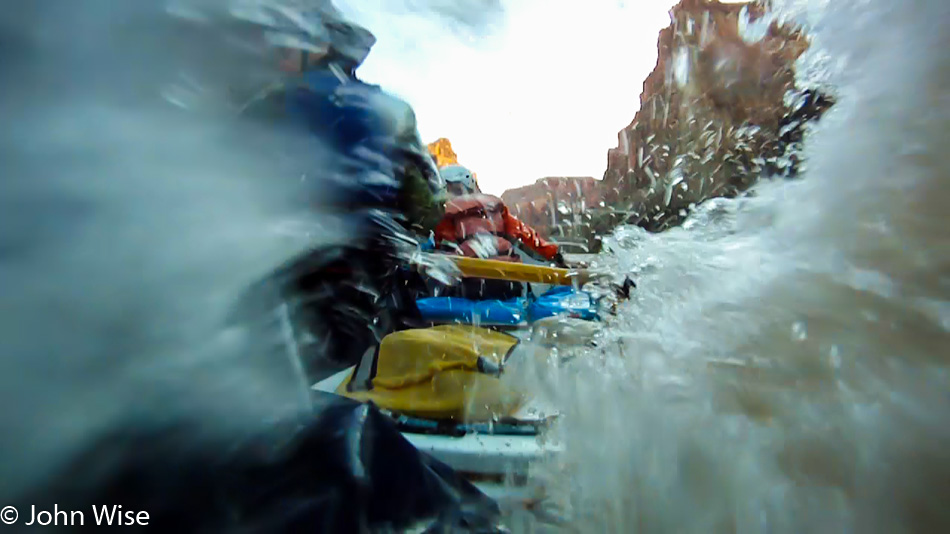
Thud, we hit a wave, and water leaps over my shoulders; yet, we are still with our heads above water and moving in a straight line. We run through another wave, but oddly, it almost feels like things are returning to calm. Is the worst over? I’m still apprehensive about turning around. The girls have been looking over their shoulders and certainly know our situation; their expressions are one of, “Okay, that was cool!”
We are near the end of Lava Falls proper, but that means we’ll have Son of Lava to contend with soon. Jeffe jumps into action, dipping left to snatch our fugitive oar from the icy grip of the river. My brain sends me the message, “What if we hit a wave while he’s leaning out there and he falls in? Am I prepared to assume the helm and figure out how, with one oar, we’re going to make it through Son of Lava?” Our luck continues, with Jeffe successfully rescuing the oar and regaining control of the Sam McGee. The tension breaks, and we share a moment of near-hysterical laughter that we have made it. The thought that it was only about 20 seconds ago that this all began is difficult to comprehend. At once, the entire ordeal seemed to have lasted no more than a few seconds, and at the same time, it was minutes before we started to bail.
With helmets still firmly attached, we prepare for Son of Lava. Probably due to its famous namesake, there is no joking or laughter upon entering this rapid. Even after what the giants of hydrology have taught us, we remain serious and focused for what now feels like the Paria Riffle we passed through on day 1.

Fast-cooling lava can form columnar basalt, as seen here. Below the lava, note the gravel layer, which is the former bed of the Colorado River before this lava flow altered its course.
Later, we found out that after Jeffe skirted us past the Hole of Doom, his oar hit a rock, which was responsible for turning us sideways. Now, set up in the wrong position, we were going to slam into that large lateral wave that should have flipped us. Kenney told me that from where he and the other boatmen sat, they were certain we were not going to make it, no ifs, and’s, or buts about it. Had Jeffe not leapt right and I followed, our little dory would have gone over, and we would have had an interesting toss and tumble down the rest of Lava Falls until we either crawled back into our boat or were spat out into the waiting arms of boatmen turned rescue team.
We have now earned the title of ABL – Alive Below Lava. Nothing left to do but float and enjoy the scenery.

Lava Falls received its name due to its proximity to a nearby cinder cone referred to as Vulcan’s Throne. During the previous 725,000 years, lava has flowed possibly four times into this river channel, building dams. The volcanic rock proved to be no match for the Colorado, and before long, the river tore down the blockages and continued its job of slicing through the Canyon. Yet, in spite of all this volcanic activity, Lava Falls was not the creation of molten rock running over the Canyon walls but the work of a major debris flow that washed out of Prospect Canyon in 1939. On our right, evidence of the spilled magma can still be seen in the basalt columns that jut and twist in all directions, creating a puzzle none of us will solve.

We are on the lookout for a sunny beach on the north side of the river; somewhere we can dry off and warm up. Until then, we float. The boatmen row every once in a while, pushing us a hair faster than the current. It is during moments like this when we are witnessing such an amazing display of nature that I want to send out a request to video game programmers and computer animators to put the first-person shooter genre to a brief rest. Create worlds for explorers instead, give those of us interested in history and the sciences a near photo-realistic natural environment that allows us to travel back in time, wander through different eras, and witness nature from throughout Earth’s history. I want the virtual me to have been there on the day when molten lava began spilling over the plateau above the river and into the path of the Colorado. How much lava flowed here before damming the river? As the water pooled behind this obstruction, where might waterfalls have begun spilling over the new rock? What kind of channels would have been carved into the basalt? Computer gaming simulations are approaching the point where the images on our screens are challenging the ideas of what is rendered and what is photographed. Will we use this to practice more killing, or will we venture into new territory in a search to explore our dreams?
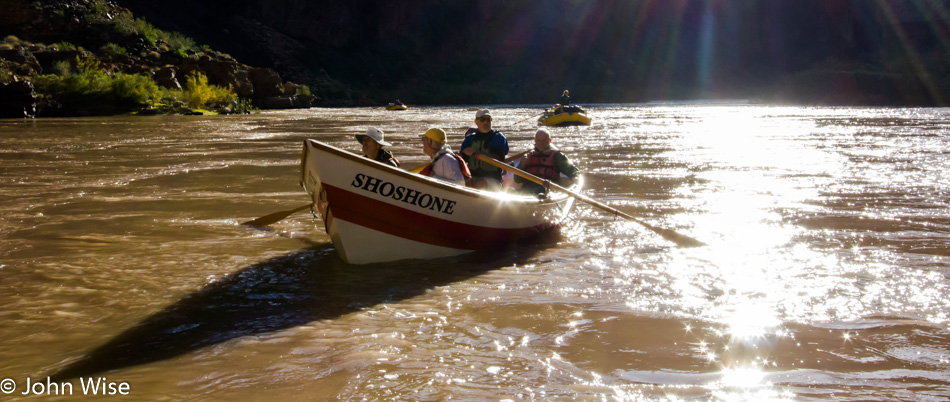
Through immersive computer animations, I want to watch torrential rainfalls accumulate, building the force necessary to move debris fields that form rapids such as Lava. Using a 3D kayak, canoe, dory, or raft as my avatar instead of a gun, I would point my craft to shore and exit into a landscape as it may have looked 250 million, 700 million, or 2 billion years ago. I am certain that at some point, we will virtually walk through 3D representations of our past amongst the early life forms to witness how dinosaurs would come to rest in river beds long before they would be found as fossils. And while we are at it, I would enjoy seeing the time-lapse process of organic matter fossilizing on its way to a petrified state. What did the kivas look like when they were in use? And, how were the crops laid out next to the Colorado? Of course, this could be applied to ancient Egypt, Rome, Beijing, and any of the other great cities of Earth, as well as other natural and historic wonders.
Our beach has been spotted. It is glowing in the radiance of the warming sun. In a few minutes, so will we. Upon landing, the boatmen start unpacking the kitchen; we are going to be treated to a hot brunch. Ah, the luxury of it all. While we peel out of our wet clothes to dry our inner layers, our dedicated guides go to work without pause setting up the grill, digging for ingredients from deep within their boats, and putting the kitchen to use. Soon, the product of their efforts will find its way into our hands and then our bellies to warm us from within.
Across the breadth of the beach, our clothes are splayed on rocks and draped over a few tree branches. We each take up the optimal angle to the sun to warm the parts we feel are our coldest. Paul stands far away from all of us, likely to ensure that no one passing him will have their shadows interfering with his absorption of warming sun rays. He has this routine dialed in. Like a cormorant standing on a rock to dry its wings, Paul has his arms fanned out at his side, his head tilted upwards, eyes closed, all the while remaining incredibly still. I’d wager his stillness is used to avoid creating micro currents of potentially chilling eddies of air as he comfortably bakes in the mid-morning sunshine.

Meanwhile, back at Café Sur Le Fleuve, the chefs are fast on the grill, ready to meet the requests of the toasty passengers who have been called in to place their orders. Brunch will be eggs and grilled bagels, with a little of this and a little of that mixed in. With our gullets full, it would be ideal to nuzzle into the warm sand for a short nap; just turn me over before I burn.
Yet the boatmen stay in perpetual motion. As quickly as they finish snarfing their own morsels, they are right back at work, cleaning up and stowing the kitchen before returning us to the river for another beautiful afternoon on the water. Who could ask for more?
As has been the routine during the previous weeks when the river allows, meaning there are no rapids of consequence in our immediate path, a river guide yields the oars of a dory to one of the boatmen who row the rafts. For our afternoon journey to camp at Hualapai Acres, Jeffe turns the Sam McGee over to Katrina. We are continuing our trek through the lava field, at least for a short while, and this includes the still chilly dark shadows, too.
Oh, is that a rapid up there? It sure is. And just where do we exchange our person at the oars for that really experienced person who was at the oars this morning, taming Lava Falls? Precisely where is he, with that little yellow raft? Well, he’s way back there. I shouldn’t worry about Katrina and her boating skills; she’s done great with the raft carrying our gear – no complaints there. But this is a rapid, and we are on a dory.
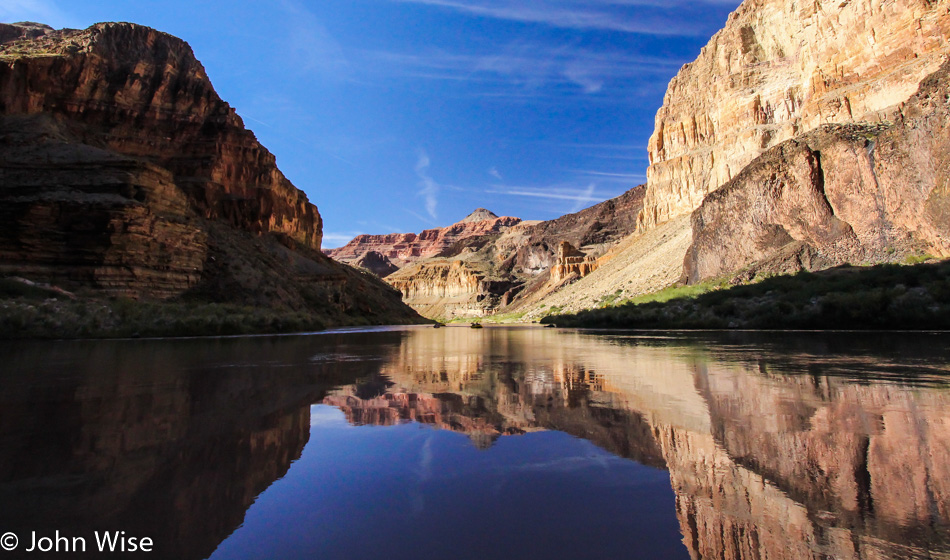
From where we are on the river, we still have about five minutes to the rapid. It’s called Whitmore, so this much I know, but it is not easy to calculate the size and descent of what is hidden up there. How can I discreetly find out its rating in order to accurately allocate my level of worry? I can’t. We are going to ride this rapid with Katrina, and that’s that. In the back of my mind are the shrewd words of the boatmen: There are three types of boatmen – those who have flipped, those who will flip, and those who will flip again. What type of boatman is Katrina today? She’s a perfect one. Not only does this M.I.T. graduate in geology and physics sing, play guitar, and a mean mandolin, she deftly moves our dory through Whitmore – even if it is a bit on the small side.
The oars dip, pull, and exit the water with the Colorado dripping from the bottom of the blade, and the cycle repeats. Our slow boat to somewhere drifts along until, on river right, a choreography of motion pulls dory and raft alike to a landing. Once on dry land and back in the glowing warmth of the sun, Kenney is leading the way toward the cliffside.

Through a thicket and up a dusty trail, we are on the climb once again. I am soon in a position to experience one of those exquisite overviews offering a panoramic look up the river. If I had but one wish for this trip, it would be that we could have at least one of these views every day. I swing around to see what lies ahead on the trail and spot a rock art panel clinging fast to the cliff face. The others move around to find their best vantage point to both see the rock art and listen to Kenney’s narrative about it. I, on the other hand, continue up the trail, looking at the string of paintings left on this stretch of sandstone, surviving many a decade, maybe even many a century, undisturbed.

My hope is to spot an intriguing figure that I can muse on, dwelling in speculation as to its meaning. In my imagination, I try to envision the person who, after arriving on foot, stood here and took the time to visually describe something from his or her world. As we arrive so many hundreds of years later, it is now up to each of us to take possession of the potential meanings of these paintings. What do these cryptic symbols and characters spell out that could offer a hint telling us who these earlier visitors were?
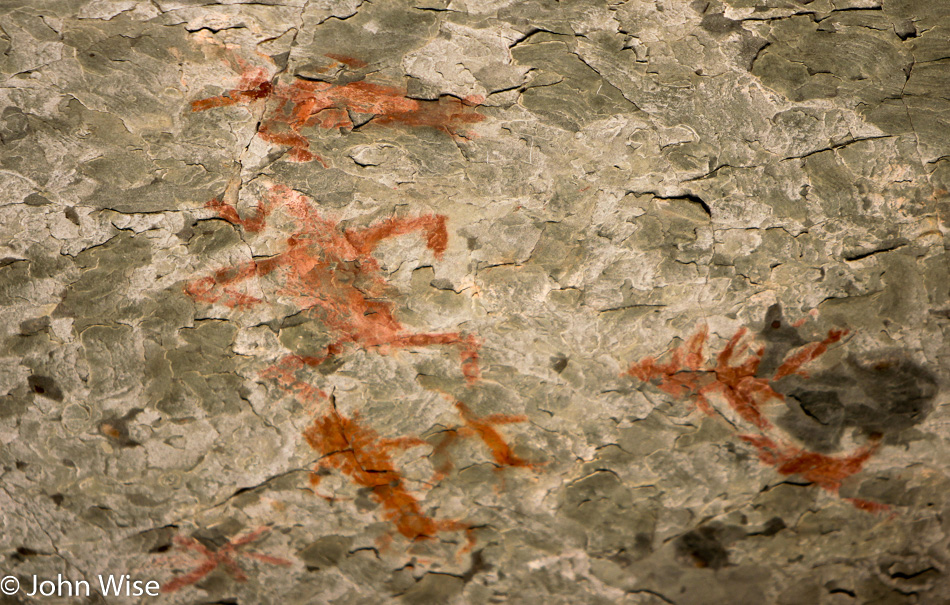
One thing their visual history tells us is that we humans have an inherent need to leave our mark. Maybe they also are a collection of clever doodles that have no real meaning at all, they are silent symbols meant to intrigue. Stop signs for all those who see them, demanding we halt in our tracks and ponder their meaning. The possible genius is that they are illusions that have tricked their viewers into taking pause right here, at a bend in the river that is nothing less than gorgeous. These early artists, not yet capable of capturing this beauty on canvas or photograph, may have planted these tokens as emblems that say, here is magnificence; this is the art we have found in our gallery of nature.
Back at the river, Katrina remains at the helm of Jeffe’s dory for the final stretch of today’s trek to mile 194. We can’t move slowly enough for me, as I want these hours on the river to forever burn their images onto my retinas and into my memories. The Canyon is quiet this afternoon, with mostly flat water around every corner; the riffles are mild and lazy. If ever there was a time to slow the hands of the clock, that moment is here and now. Two weeks ago, the days before me felt endless. The finish line was standing at a distance that offered no sense of ever reaching it. Today must be enjoyed as long as possible, as long as any one of the first 14 days. I must savor this continuing series of amazements that facilitate my escape from the pull of the artificial reality I call – normal life.
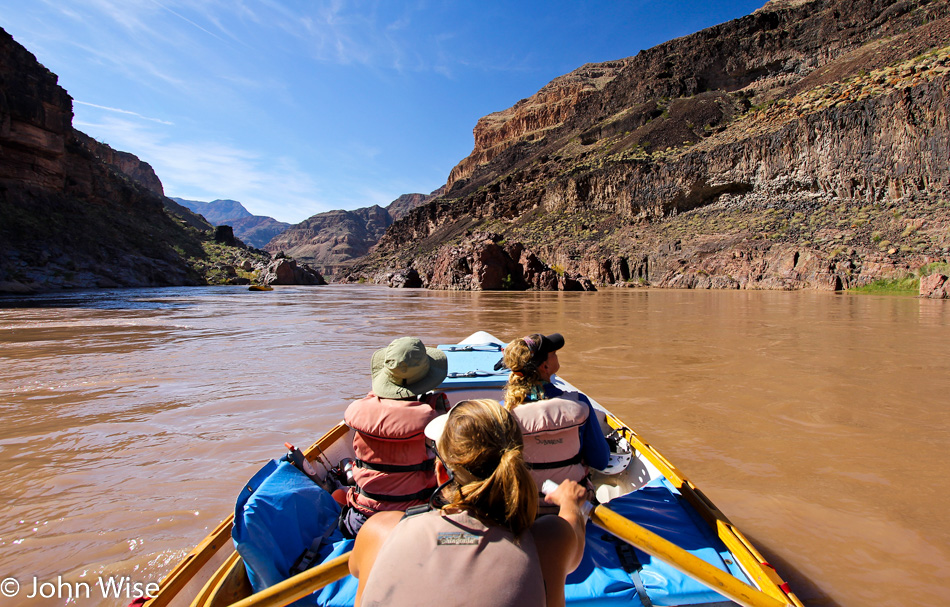
This journey down the Colorado, maybe it, should always remain out of reach for the majority, a story left unread, as not only do the waters strip away layers of earth to create a canyon, but this ecosystem is grinding through human contrivances, stripping away the layers of societal conditioning that have placed artifice in the spotlight, and have painted nature as something false or, at best, a resource to be exploited for our financial gain. You cannot come here and engage yourself in conversation with the Canyon, find its intimacy, explore its beauty, witness the flickers of enlightenment, and not fall in love with this thing that may not be much more than a collection of rocks, water, and cactus to the uninitiated. If one can touch that part of the soul that knows and understands the beauty found in all things and still denies the magic found here in nature, that person cannot be truly human.
As a society, we are condoning cynicism on many levels, and it is, in effect, robbing us of our sense of wonder and hurting our appreciation of the natural world. This blind acceptance of the negativity that cynicism produces is used to push one another into avoiding responsibility for our planet; it is an intellectual act of violence waged against our future. People of today hold the keys to enlightenment, as it is we humans who possess the ability to distill the universe into the observable. We are the inheritors of the creativity that has raised our station on this planet to grand heights. It is time to reawaken these senses of knowledge and imagination from dormancy and prevent their death so that we earthlings can offer our contribution to making the entire world a better place, not just our individual lives. Without bringing someone else, everyone else, on such a river journey, how do we demonstrate or otherwise convey the sense of love and passion found in nature that can be known as intuitively as the lesson that was taught to us at an early age that one plus one equals two? Who does our continued lack of broad knowledge and near halt in learning about ourselves within nature benefit? Is it just me, or are we encouraged to remain in a perpetual state of mental infancy and, in turn, dependent on a herd mentality for our individual validation?

When will society at large learn to understand who their personal boatmen are and what journey they are being guided toward? Why are we taught to be afraid of the mind, the intellectual, the exploration of our own mental canyons, and of nature itself? Might a glimmer of illumination upon the shadowy recesses of the human spirit loft us to a point of happiness and love that can be found here in the Grand Canyon? If you haven’t figured it out yet, I have taken permanent residence on the Colorado River, at least in spirit. A part of me will live here forever. Just as the Native Americans left their imprint on sandstone walls so that they, too, may stay longer than their physical reality allowed, I pen this journal and subsequent book as my pictograph detailing what I found on my visit to this chasm etched on Earth.
I had glimpsed hints of what was in store for me on earlier travels when Caroline and I ventured into National Parks such as Yellowstone, the Redwoods, and Death Valley. Each of these locations, and hundreds more, have all kept some small part of us that then acts as a magnet, tugging at us for our return. But the force here in the Canyon feels like a superconducting electromagnet that will hold our presence, demanding a future return to bring us back to reconnect with what we will leave behind. But how will I ever again find all the tears that have been shed, all the love that has been spilled, and the fleeting images of beauty that were to be had for an instant before having to let them go?
We’ll float a few more minutes before checking in at the Hualapai Acres Beach Side Resort, although the resort side of things never really got a foothold, this being a National Park and all. A sandy patch of land will play home to our tent castle this night; who needs resorts anyway? A beckoning to start the “Parteeee!” is announced over the public address system called Rondo: “All hands on deck, we are meeting on Ashley’s raft. Let’s go; everyone can make it; we’ll get you there.” Armed with a bottle of bourbon and a bottle of scotch, the celebration of being Alive Below Lava is about to get underway on the party boat.
While fairy tales often begin with “Once upon a time,” a boatman’s story opens with, “No shit, there we were!” This is a popular refrain here this early afternoon. Camp is set up, tents pitched, and the Unit deployed before the alcohol starts to flow at 3:00 pm. Within minutes of the first shots from the communal bottles, Rondo bellows off a “No shit, there we were” and then treats us to a story about dangerous rapids, the fate of a blow-up doll posing as a passenger being tossed into the river, and the ensuing panic of the boatman who wasn’t in on the joke.

Andrea Mikus was one of the three boatmen who worked hard to provide any and all assistance required on one of these arduous trips. Their payoff: to be a Grand Canyon guide.

Katrina Cornell. Here in The Big Ditch, the job of river guide is an honor that only the rare individual will ever be awarded. These three women are close to reaching that goal.
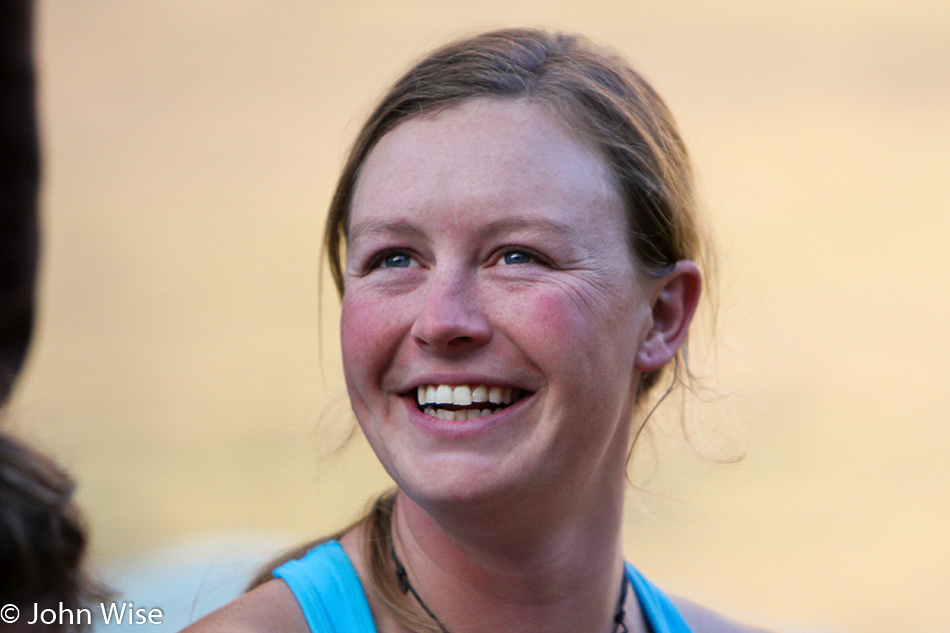
Ashley Brown. Expertise, knowledge, heart, and soul are the tools of great boatmen. We were fortunate to have all of that and more from these future Canyon guides, our swampers.
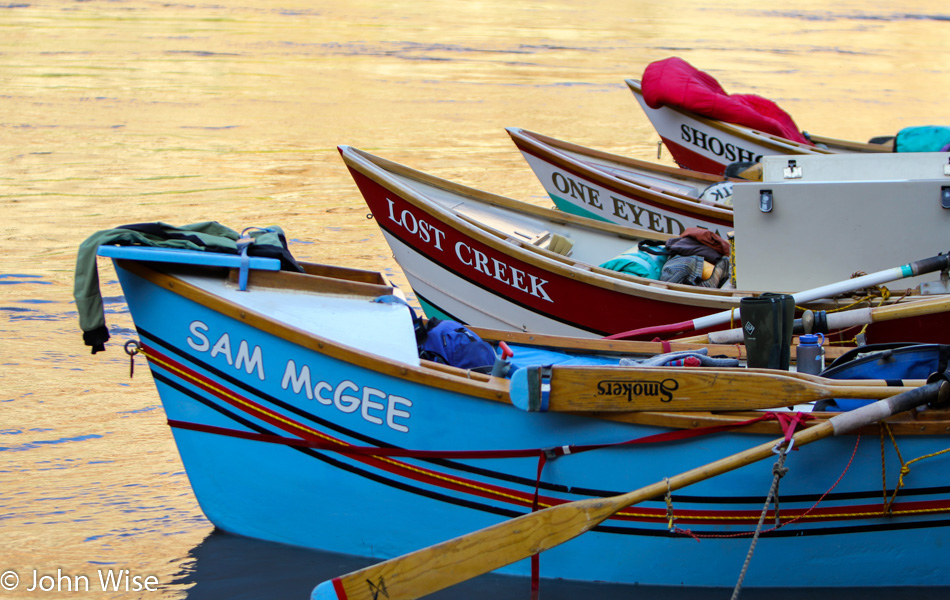
Laughter is the unifying emotional expression that acts as a temporary remover of burdens and stress; there must be a deity out there just for the purpose of bringing levity. Stories of boat flips, drinking, and broken rules push all of us into rolling laughter. The best stories end with the now familiar “I can’t make this shit up” in place of “and they lived happily ever after.” If you learn nothing else about boatmen, it should be that these people on larger-than-life quests for adventure are full of great yarns that are woven out of a life of chance encounters and peculiar situations. The enthusiasm of our river guides brings us right into these tales as though we were there when they happened.
Jeffe uses a break in the storytelling to leave the group. The determination he departs with tugs at my curiosity, and so I follow. He’s on a mission. First, Jeffe grabs the big orange five-gallon coffee thermos, then heads over to the kitchen. Next, his quest takes him deep into the hull of a dory, digging up an assortment of things. Out of view of the others, he opens four half-gallon cans of pineapple juice and dumps them into our empty coffee pot, along with two bottles of coconut cream and a half-gallon of rum. Then, picking up the thermos and another half-gallon of rum, he returns to the party boat.
“Listen up,” he says. “The tradition down here is to be democratic about how strong we make our celebratory pina colada for toasting being Alive Below Lava. It will be determined by the group how much of this now open bottle I am going to add. Here goes, just tell me when it’s enough rum. Did I mention that I already added a half-gallon? Well now, here we are approaching half of this bottle and if one were to feel that this here pina colada was about strong enough, it would be a good time; oh, the bottle is empty!”
Drink up and be merry. After the group leaves Ashley’s raft to fetch their cups and take a dip from the communal bucket, the girls move back to the raft while the guys take up seats around the fire. As time went on, giggly outbursts would explode from the raft while us guys seriously go about the business of solving the world’s problems. Now, with everything set into motion that would cure humankind’s ills, it is time for another amazing dinner.
I still don’t know how anyone could see through the alcohol to prepare dinner, though this is just what our cooks do. Of course, it is seriously dark by the time we eat – great camouflage for what may not have been flawless, except this really was a perfect meal.
Before digging in, Rondo gets up with a drink in hand, “Tonight, for your dining pleasure, we are having steak made to order, mixed vegetables of baby corn, green beans, fresh broccoli, quinoa, and a salad. After dinner, we will have a light and tasty dessert.” The vegetarian option, a veggie cutlet, Caroline insists, is tasty as well – I offer, “Sure it is; after enough alcohol, you could eat my river shoe and enjoy it.” I am the first one done with the carnivorous extravagance; in all likelihood, this is due to the fact that I may be the only one not moving in alcohol-induced slow motion – I’m not a drinker, but I am, however, a voracious eater. Like a dog, I start milling around the grill, secretly hoping for scraps. Kenney reads me like a book and offers me the last steak – that scrumptious and delectable filet is mine; the feast continues.
Rondo calls out, “Hey, you guys, and especially you new guys. Oh my gosh, what a day! Let’s hear it for Linda, who saved our swimmer in Lava.” A big “Woo-Hoo” goes up. Andrea tries one last time to clarify things about her time overboard in Lava Falls, but the truth will not get in the way of a good story; the legend is already set – Mom Saves Daughter! “During the past two weeks, you have been entertained, told stories, and sung to by us boatmen. In two days, on our last night in the Canyon, it is your turn to entertain us on the ‘No Talent / Talent Night.’ You have two days to prepare. In a moment, Frank and Linda will start delivering dessert, which, of course, is a personal favorite: Dutch Oven brownies. Hey, you guys, I LOVE MY JOB!”
It’s 7:30, and most of us have been going for 15 hours now. Paul and Ellen are the first to stumble away from the fire, laughing into the darkness in their attempt to find the tent they set up five hours ago while still sober. Joe is snoring before his head hits the canvas. To clarify, this 76-year-old guy never once set up a tent. He would unfold a tarp, unroll his sleeping bag, and, as close to the river as he could get, he would sleep under the stars. On the nights we had a bit of rain or high winds, he would pull a second tarp over his sleeping bag and continue sawing logs. Out in the distance, the laughter of the lost campers, Paul and Ellen, keeps us chuckling around the fire. A voice insists the tent is this way, with a giddy answer coming back that it is not to be found over here, either. We decide not to help but to stay here, being entertained by their antics.

The next couple of hours are spent around the fire. There may have been some music, maybe another story or two; it could also be that we listened to the crackle of the fire. But what really stood out was a poem. A poem about life on the river, written somewhere on the Middle Fork of the Salmon River, by our boatman Stephen Winston Kenney.
A State Of Grace
All my life I have searched for a Sense of Place
To find the tempo to set my Sense of Pace
River life creates such an amazing Space
Running water finds me in a State of Grace
Those long flat stretches floating on liquid glass
Living in the present and not the past
The water’s silence as you feather your oars
No matter the stretch, it leaves you wanting more
The undulating curves at a rapid’s edge
The serenity fades as you drop the ledge
Once you have committed to the Mother’s tongue
Your fate to the river cannot be undone
The mixture of Power and Fragility
Rapids in their glory are a sight to see
Enjoying low water runs and springtime floods
Running crystal clear, sometimes like liquid mud.
Each time she has a nature all of her own
You never forget the wildness she has shown
The bright Dories running high, wide, and handsome
Taking your everlasting Soul for ransom
Driving a sweepboat down alone in the Church
It’s another place where your soul may be searched
Hearing a Canyon Wren at the break of day
The smell of cowboy coffee floating your way
Catching reflections of the cliff sides above
Side canyon hikes that can’t, but fill you with love
Late afternoon light that envelopes us all
Fiery sunsets which ignite the Canyon walls
The casting shadows at the end of each day
The Quiet that surrounds you in such a way
Our hardships and friendships blend with laughter
Touching so many lives, making them better
The look in the eyes of a fellow brother
Raised apart but wedded to the same lover
Some memories are momentarily lost
But I know the feeling each time I push off
I am blessed to have been shown such majesty
I shall ever dream of her great mystery
In this World, I have found that Sense of Place
Heavenly waters set my Sense of Pace
My River Life creates my personal space
Running water finds me in a State of Grace
–From my book titled: Stay In The Magic – A Voyage Into The Beauty Of The Grand Canyon about our journey down the Colorado back in late 2010.
